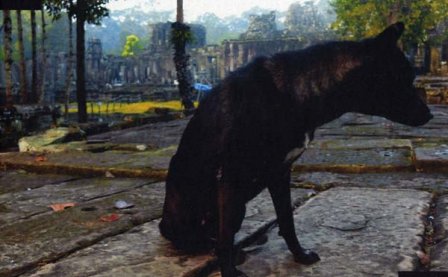The Keiji Haino/Jim O’Rourke/Oren Ambarchi trio tempts me into wide-eyed idolatry. If you asked me to describe the ensemble in brief, I’d descend into, “You know who these guys are, right? No? They’re everything. The classics are out there, man — these guys have gotten around.” A complementary mythologizing process colors discussions of the style of “free” music that the trio records at its annual gig at SuperDeluxe in Tokyo: free music as a force of nature, a fateful and happy accident, an alignment of planets and players that yields a truly serendipitous event. A more grounded interpretation holds that a session of seasoned musicians, however rhythmically or harmonically loose its conditions, constitutes a snapshot of ideas and skills that each person workshopped over many hundreds of hours of playing. The strategies (beats, riffs, solos, effect parameters, pedal chains, instrumentation decisions) that reach our ears, then, just happen to be the ones someone catches between a [REC] and a [STOP].
Even divorced from mythology, the H/O/A trio thrills. In the scope of their four albums to date, Now While It’s Still Warm Let Us Pour in All the Mystery represents a departure from the 15- to 22-minute sessions of prior releases into the territory of the Somewhat More Conventional Album. Although still performing live-as-hell “free music” (as if Haino’s presence could allow for much else), they deliver a 45-minute dynamic sequence that spreads its climaxes and moments of serenity across shorter tracks, a change that could turn off listeners awaiting the endless vamps and in-the-red screech that characterized much of Imikuzushi and In A Flash Everything Comes Together As One There Is No Need For A Subject. This isn’t to say that Haino sits still or conforms to expectations here; he arrests the listener with every decision. The fact that Ambarchi and O’Rourke have cohered into a more focused rhythm section than ever attests to their versatility as “rock” musicians (i.e., shredders) and their developing perception of which strategies best accompany Haino’s performance.
If first recording Tima Formosa found the trio in a mode of improvised electro-acoustic drone, with Ambarchi’s motorized guitar and sub-bass drops and O’Rourke’s prepared piano meshing into a wall of Haino’s processed guitar, opening track “Once Again I Hear The Beautiful Vertigo…” taps into an even deeper hypnotic headspace. The addition of contemporary minimalist Charlemagne Palestine and improviser/singer-songwriter Eiko Ishibashi to the trio cements the all-star pedigree, but all five perform on wine glasses, each individual’s output blurring into a united drone of high-end overtones. On record, the wine glasses don’t quite overwhelm or even rise above a distant hum. But a video of the performance reveals why: the musicians strolled around SuperDeluxe’s stage at leisure, eschewing close mic-ing to fully inhabit the physical space.
If any portion of Now While It’s Still Warm will turn off casual Haino listeners, if such people exist, it’s the flighty woodwinding he displays on “Who Would Have Thought…,” which is somewhere between an Eric Dolphy solo and a midnight ritual. O’Rourke’s ring-modulated bass forays spew forth and confound, as Haino’s shouts puncture the subdued atmosphere. The pacing and stretches of silence recall Haino’s 1990 watershed Nijiumu and his subsequent Era of Sad Wings album released under the name Nijiumu; both contain sprawling, pitch-black sessions of primal improvisation that drift at murmured volume until Haino interjects a howl or a peal of flute. Within the context of the H/O/A trio, Now While It’s Still Warm’s opening tracks distill Nijiumu’s precedent and demonstrate Haino’s honed sense of dynamic tension. He need not rely on volume and noise to convey intensity.
Volume and noise, thankfully, arrive shortly afterward. The following tracks find the trio back in the savage psych territory of Fushitsusha, but possessing a rhythmic focus discernible from the looser improvisations of Haino’s flagship project. Over 35 years of on-and-off existence (currently on), Fushitsusha has covered enough ground to make generalization impossible. That said, the group’s rhythm sections over the years have forsaken united grooves to a greater degree than O’Rourke and Ambarchi here. O’Rourke tends to settle into short phrases centered around one harmonic center: swooping slides down the fretboard, two-note chugs, spastic bursts that span multiple strings before returning to the root. He repeats a riff for minutes at a time before escalating into another, often along with the toggle of an effects pedal. More than any of his contemporary releases, his playing here hearkens back to the mechanical caterwaul of Brise-Glace’s and Gastr del Sol’s more aggressive moments. Ambarchi, meanwhile, lands on a beat and hammers it to death. His repetitions channel both the motorik and the insistent space-rock pulse of Hawkwind, but manifest as more of an industrial grind, often with a count left open at the end of the measure like the pause of a machine resetting. If last year’s percussive Sagittarian Domain sent the needle on a fluid journey down the record’s grooves, Ambarchi’s drums catch in a lock groove here, looping until a shift in his bandmates’ performance bumps him into a new configuration.
With O’Rourke and Ambarchi as his own personal This Heat, Haino spreads out and does his thing: his solos sear; his vocals boom and echo across the room with a spit-shooting passion best compared to screaming singer-songwriter Kazuki Tomokawa; and his riffing shifts between atonal chord clusters, washed-out fuzz, and tenuous clean-toned exploration. With his reverb and distortion pedals on full blast, he delivers string-mangling tremolo-picked passages ferocious enough to enter the Haino Hall of Fame (check out what happens at the six-minute mark of “Even That Still Here…”). But this shouldn’t come as a surprise. Haino’s style is so idiosyncratic that each of his releases falls into a decades-long continuum of challenging, hyper-expressive performance. Even within the H/O/A trio’s small catalog, some elements carry over so fully as to make these once-a-year concerts seem like they happened on consecutive nights: “A New Radiance Springing Forth…,” for example, finds Haino howling “imikuzushi” as a refrain. The phrase translates to “significance destroyed,” but I’m not about to assert that the H/O/A trio “destroys significance” with their jams. We’re capable at this point of demythologizing their annual reunions and tracing their development as an ensemble. By the time the title track ends the album with another brief meditation, Now While It’s Still Warm Let Us Pour in All the Mystery proves its significance as a showcase of three boundless improvisors refining their strategies, reining in their excesses, and pressing [STOP] before they sink in too deep to escape.
More about: Keiji Haino / Jim O'Rourke / Oren Ambarchi




